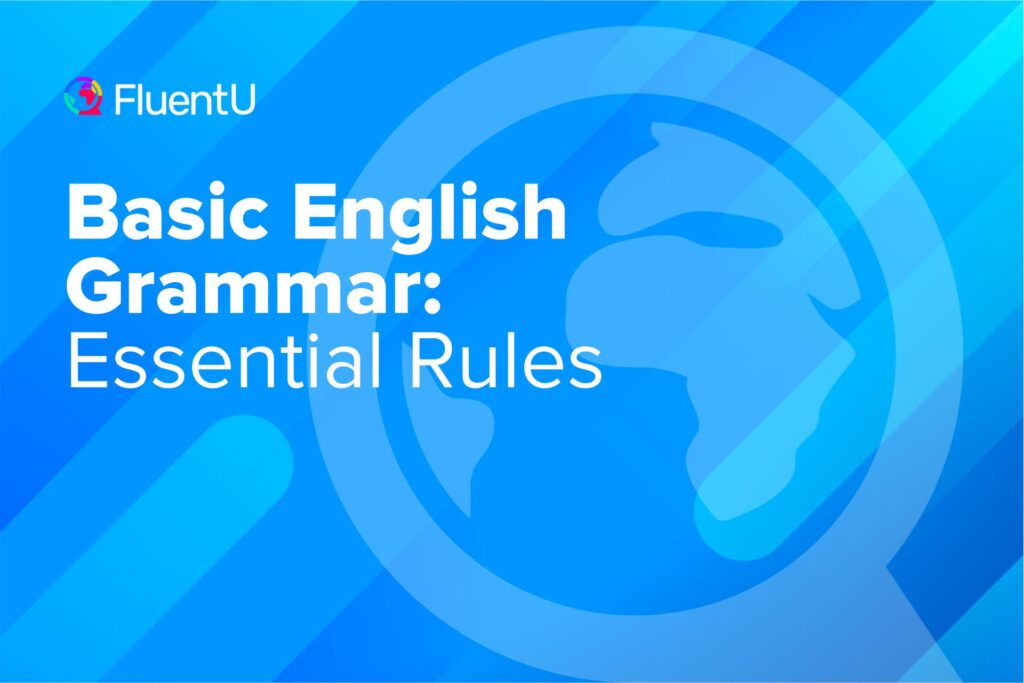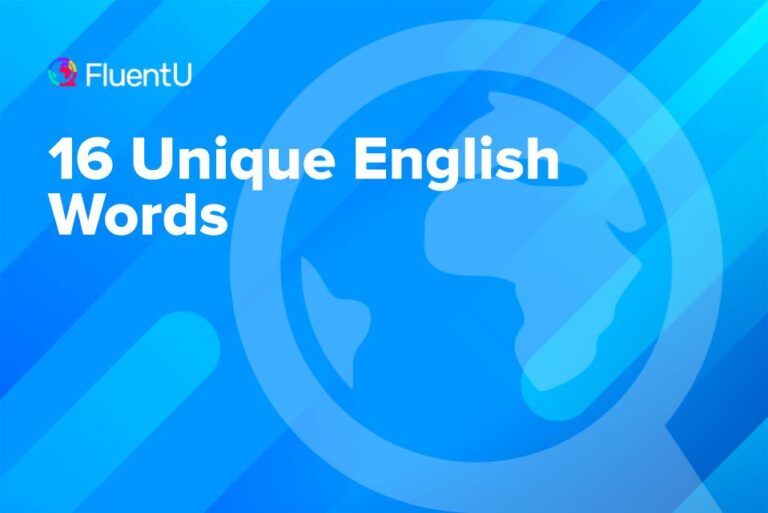Basic English Grammar: Essential Rules

As a beginner in English, you shouldn’t stress too much about being grammatically perfect. Even native speakers slip up on grammar, especially in conversation.
However, by starting to learn basic English grammar, you will be surprised how rapidly your English language abilities will progress. So, if you’re ready to start building, let’s go ahead and lay down that foundation.
Download: This blog post is available as a convenient and portable PDF that you can take anywhere. Click here to get a copy. (Download)
Nouns
Singular vs. Plural Nouns
Nouns are naming words. Nouns will be the first words you learn when you start learning a new language.
Nouns can be both singular, referring to one person, place, thing or idea, or plural referring to multiple people, places, things or ideas.
The end of the noun changes to transform it from singular to plural. This will differ depending on the end of the word. For most nouns, simply add an -s to the end to turn it into a plural noun.
Also note that for some words, the pronunciation changes when changing from singular to plural.
| doctor | doctors |
| mountain | mountains |
| cat | cats |
| thought | thoughts |
For nouns that end in a -ch, -x or -s, add -es to turn the word into a plural noun.
| church | churches |
| tax | taxes |
| eyeglass | eyeglasses |
Add an -es to nouns that end in -f or -fe while also changing the -f to a -v.
| half | halves |
| calf | calves |
| knife | knives |
The spelling of some nouns changes in the plural form.
| man | men |
| child | children |
| goose | geese |
| tooth | teeth |
| person | people |
Words ending in -o or -y are tricky as they don’t have consistent rules you can follow to change them.
Most of the time, merely adding an -s to the end of a word that ends in -o is sufficient. However, sometimes, the word requires an -es at the end.
| hero | heroes |
| burrito | burritos |
For words that have a consonant before the -y, you usually add a -ies to the plural form. If there’s a vowel before the -y, then simply add an -s to the end of the word.
| lady | ladies |
| city | cities |
| tray | trays |
Some words stay the same in both singular and plural forms. Many of these are animals, but not all!
| sheep | sheep |
| moose | moose |
| fish | fish |
| aircraft | aircraft |
Possessive Nouns
Add an apostrophe and an -s to nouns to make them possessive and indicate who the owner of something is.
Mary’s dress
Dad’s car
Jenny’s shoes
Add an apostrophe to the ends of names already ending in -s.
Jess’ book
The teachers’ chair
The kids’ playground
When talking about two people owning a single object, only add an apostrophe and -s to the end of the second person’s name.
Mom and Dad’s house
David and Jen’s dog
Susan and Elodie’s table
To describe a situation where two people own separate things, add an apostrophe and -s to both people’s names.
Aunty’s and Uncle’s books
Carol’s and Susan’s shoes
Josh’s and Tom’s houses
Pronouns
Pronouns replace the noun in a sentence. There are various types of pronouns such as relative pronouns, demonstrative pronouns and reflexive pronouns.
The most basic type of pronouns are personal pronouns, which include I , You , He , She , It , We , They , Us and Them .
For example, the sentence “Jonathan goes to work at eight in the morning,” can be altered to, “He goes to work at eight in the morning” using the pronoun he.
Another example is, “Mary and Joe spent the day gardening,” which would change to, “They spent the day gardening.”
And for extra practice, “The story was exciting,” can be changed to, “It was exciting.”
Adjectives
Adjectives are describing or modifying words for nouns.
In English, adjectives are typically placed in front of the noun.
Beautiful flower
Blue ocean
A sunny day
Colorful feathers
Adjectives with Negative Prefixes
Adding a un-, in- or dis- to the front of an adjective is often an easy way to give it the opposite meaning.
| common | uncommon |
| interested | disinterested |
| definite | indefinite |
| assemble | disassemble |
Strings of adjectives have a specific order they should be placed in. This order is size or shape, age, color, origin then material.The small, old, yellow, English stone cottage.
The large, red and white Dutch tulip.
The long, new, pink silk skirt.
Comparative and Superlative Adjectives
When comparing two things, use a comparative adjective. For comparisons of multiple things, use superlative adjectives.
Form comparative adjectives by adding an -er and -est to form superlative adjectives on the end of one-syllable words.
| soft | softer | softest |
| old | older | oldest |
| short | shorter | shortest |
For words ending in a -y, change the -y to an -i then add an -er for the comparative adjective and an -est for superlative adjectives.
| pretty | prettier | prettiest |
| happy | happier | happiest |
| busy | busier | busiest |
The spelling doesn’t change for adjectives with more than one syllable. Add the word more in front of these words to make the comparative adjective and most for superlative adjectives.
| beautiful | more beautiful | most beautiful |
| exciting | more exciting | most exciting |
| peaceful | more peaceful | most peaceful |
Some adjectives have different forms when turning them into comparatives and superlatives.
| little | less | least |
| many or much | more | most |
| good | better | best |
| bad | worse | worst |
Comparative adjectives typically have the word than in front of them to create comparisons.
This pillow is softer than the other one.
My dog is happier than my cat.
Sitting in this garden is more peaceful than in my garden at home.
There is less than there was yesterday.
The word the usually accompanies superlative adjectives.
John is the oldest in the classroom.
Mary is the happiest person I know.
Simon is the most respectable person in the room.
This is the worst day of the week.
Verbs
Be Verbs
Verbs are used to indicate an action, state or occurrence in a sentence.
A state of being is shown using be verbs. As the name suggests, action verbs express action. Verbs can also indicate the past, present or future tense, so you understand when in time, the action or occurrence happened.
When turning a be verb into a negative, add the word not in front or shorten it to aren’t for are not, isn’t for is not or hasn’t for has not.
Here are some examples of be verbs:
I am a gardener.
She likes the smell of roses.
Sunbathing on the beach is my favorite activity.
They are very friendly.
Action Verbs
Here are some examples of action verbs:
I ate a salad.
She walked the dog.
He ran through town.
John swims in the ocean every day.
If you want to see 150 real examples of common verbs in action, have a look at this video:
Regular Verbs
When using regular verbs, simply add an -ed to the end of the original form to indicate both simple past and past principal.
Here are some regular verb examples in original, simple past and past principal form:
| walk | walked | walked |
| smile | smiled | smiled |
| cook | cooked | cooked |
| watch | watched | watched |
| listen | listened | listened |
Irregular Verbs
Irregular verbs don’t follow a standard formula when using them in the past tense; however, some patterns can be seen.
Below are a few common irregular verbs in original, simple past and past principal form:
| rise | rose | risen |
| bite | bit | bitten |
| choose | chose | chosen |
| break | broke | broken |
| grow | grew | grown |
| know | knew | known |
| fly | flew | flown |
| hit | hit | hit |
| bet | bet | bet |
| cut | cut | cut |
If you’d like to learn more about irregular verbs and how to use them, check out this video:
Adverbs
Adverbs give more information about the verb, adjective or another adverb in the sentence.
Verb: The train is fast.
Adjective: The sun is strikingly hot today.
Adverb: The flower is opening very slowly.
Adjectives can often be turned into adverbs by adding a -ly to the end.
| complete | completely |
| quick | quickly |
| beautiful | beautifully |
When the adjective ends in a -y, remove the -y and add -ily to the end.
| lazy | lazily |
| happy | happily |
| crazy | crazily |
Tenses
Verb tense adds time information into a sentence. A few basic ones are the simple tenses which include the present, past and future tenses.
Present Tense
The tense used in the present form is the original verb form.
I watch a movie every week.
You swim competitively.
I eat noodles for lunch.
Past Tense
Verbs often alter slightly when using the past tense.
I watched a movie last week.
You swam competitively.
I ate noodles for lunch.
Future Tense
Add the word will in front of verbs to indicate future tense.
I will watch a movie this week.
You will swim competitively.
I will eat noodles for lunch.
Coordinating Conjunctions
Conjunctions are one of the most basic ways to join words, phrases or clauses together into one sentence.
Commonly used coordinating conjunctions include the words for , and , not / nor , but , or , yet and so .
Include for in a sentence as a replacement to the word because to show purpose or reason.
We went on holiday, for we love to travel.
I bought a new dress, for tonight is the Christmas party.
When using and in a sentence, it means in addition to and is used to connect ideas.
I want to eat ice cream and candy.
Mary will give you her old baby clothes and cot.
Add negativity into a sentence with the words not/nor.
I want pizza, not pasta.
She didn’t reply to my phone message nor email.
Using but adds tension to a sentence and creates contrast or a contradiction.
John went to the supermarket but couldn’t find celery.
I wanted the purple dress, but they didn’t have my size.
To add choice into a sentence, use or.
Do you want a yellow bag or a purple bag?
I either want the flowers or the tie-dye fabric.
Like but, using yet in a sentence adds contrast. The difference is that yet means nevertheless or at the same time.
He is nice, yet he has a big ego.
She swam very fast, yet didn’t make it to the finals.
The word so adds cause-and-effect information to a sentence.
I heard fantastic reviews about the movie, so I bought tickets to see it.
Mary loves the color yellow, so I bought these yellow flowers for her.
Why Learning Basic English Grammar Is Important
Improves Your Communication Skills
Learning proper sentence structure through basic English grammar is important to improving your communication abilities.
As you talk and write to people using these commonly understood sets of grammar rules, people will find it easier to understand you.
Instead of simply having a list of jumbled words, grammar organizes and glues your words together in a way that native English speakers understand.
Enhances Your Reading Comprehension Abilities
Learning English grammar isn’t all about people simply understanding you; it’s also about you understanding the spoken and written words around you.
Comprehending basic English grammar helps you to better interpret books, street signs, menu’s in restaurants, email correspondences, and so much more.
The written language is all around us, and learning a new written language opens up to new worlds of ideas and culture.
Imagine how much more you will learn and enjoy when traveling in an English-speaking country when you can read what’s going on around you.
Prepares You for Intermediate English Grammar Rules
We all have to start somewhere. Advanced English grammar can be very complicated, so as a beginner English learner, a valuable grammar learning tip is not to get overwhelmed at the start.
Begin with mastering basic English grammar rules before you dive into learning intermediate and advanced rules to give yourself a solid base to build on.
Methods for Learning Basic English Grammar
Start with Basic English Lessons
An easy way to get overwhelmed when learning a new language is to jump ahead too quickly. Save yourself from getting overwhelmed by starting with the basics.
Start by practicing basic English lessons either online, at home or in a classroom setting.
A highly recommended English grammar book for those who wish to learn at their own pace is “Basic Grammar in Use” by Raymond Murphy.
Utilize Real-Life Examples
It’s one thing to understand perfect classroom English and a very different thing to apply it to real-life scenarios.
With such a vast number of English speakers around the world, you will find an enormous amount of different accents and slang. This can make real-life English challenging if you haven’t been exposed to it.
One way you can do this is by using a language learning program such as FluentU.
FluentU takes authentic videos—like music videos, movie trailers, news and inspiring talks—and turns them into personalized language learning lessons.
You can try FluentU for free for 2 weeks. Check out the website or download the iOS app or Android app.
P.S. Click here to take advantage of our current sale! (Expires at the end of this month.)

Practice with quizzes and games
Trying to memorize all the specific grammar rules and tenses can be dull. Use language learning quizzes and games to make learning basic English grammar fun.
Websites like Quizlet allow you to create your own flashcards with words and photos or you can search for pre-made decks.
Now that your basic English grammar foundation is laid, you are ready to start constructing sentences and building on your conversation, writing and reading skills.
Download: This blog post is available as a convenient and portable PDF that you can take anywhere. Click here to get a copy. (Download)
And One More Thing...
If you like learning English through movies and online media, you should also check out FluentU. FluentU lets you learn English from popular talk shows, catchy music videos and funny commercials, as you can see here:
The FluentU app and website makes it really easy to watch English videos. There are captions that are interactive. That means you can tap on any word to see an image, definition, and useful examples.
For example, when you tap on the word "searching," you see this:
Learn all the vocabulary in any video with quizzes. Swipe left or right to see more examples for the word you’re learning.

FluentU helps you learn fast with useful questions and multiple examples. Learn more.
The best part? FluentU remembers the vocabulary that you’re learning. It gives you extra practice with difficult words—and reminds you when it’s time to review what you’ve learned. You have a truly personalized experience.
Start using the FluentU website on your computer or tablet or, better yet, download the FluentU app from the iTunes or Google Play store. Click here to take advantage of our current sale! (Expires at the end of this month.)











